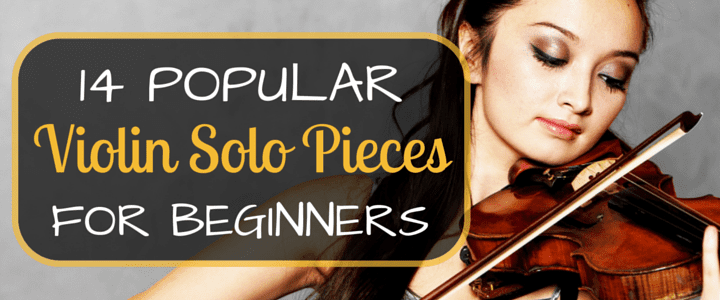Just starting out on violin and not sure where to begin with violin solos? Here, violin teacher Naomi Cherie S. has outlined 15 popular violin solo pieces to help you build your beginner repertoire. Whether you’re brand new to the violin or you’ve been playing for a year or two, this list has some great songs for you to tackle…
Note: We’ve included videos, violin tutorials, and violin solo sheet music to help you master these songs!
What is the Best Violin Solo?
There are dozens of excellent violin solo pieces out there – and while it can be tough to find the best violin solos as a beginner, you certainly aren’t limited. Here are five of the best violin solos to master:
- “Lightly Row”
- “May Song”
- “Allegro”
- “Happy Birthday”
- “Perpetual Motion”
Don’t be afraid of keeping it simple, either! While it’s tempting to try to learn more complex tunes like the “Niccolò Paganini 24 Caprices for Solo Violin” (Paganini is a famous composer of solo violin etudes, if you didn’t know) as soon as you start learning how to play violin, you don’t want to get overwhelmed. Here’s a video with some basic violin songs you can master as a newbie:
What You Need to Know About Violin Solos
As a musician, violin solos are great to develop skills outside of beginner exercises and scales. Solo pieces can also give you a great excuse to test your playing abilities beyond your studio or bedroom.
Even if you’re not too keen on performing in front of an audience, the ability to perform in front of people is very important in your journey to becoming a well-rounded musician, especially if you plan to perform in an orchestra, band, duo, or quartet.
By starting small, with a group of friends or family, you’ll learn to control your nerves and perfect your stage presence and presentation, and eventually, you’ll have no problem performing in front of large crowds!
It’s important to have a violin solo collection, made up of comfortable, familiar songs to build your confidence to perform in front of an audience. These violin solos will help you prepare for a planned recital, family holiday, or an impromptu request.
Where to Find the Best Violin Solo Sheet Music
Don’t know where to find violin solo sheet music? Whether you’re looking for beginner violin solos, intermediate violin solos, or advanced violin solos, the Internet is a great place to start your search. You can often find free violin sheet music, too!
The outline of songs in this post uses the internationally known “Suzuki Violin School: Violin Part, Vol. 1” as a base. Since it’s one of the most popular beginner violin books in the world, it’s easy to find at music stores and does a great job of slowly introducing concepts.
Keep in mind: you don’t need to be learning in official Suzuki Method style (Suzuki method is a teaching style developed by Shinichi Suzuki in the mid 20th century) in order to use this book. It’s just a good, affordable series of song books with a lot of great beginner material.
Many of these are folk songs or are adapted from classical pieces by well-known composers and can be found online or in other books, however, Suzuki lays it out in a neat, easy-to-follow package. We’ve also thrown in a couple of party favorites and crowd pleasers.
Time Frame and Experience
The songs below are organized by experience level. Please note, the time frames are estimates and can vary from student to student. You can enhance your results with violin lessons and consistent practice.
What Are the Most Famous Violin Solos?
These violin solo pieces are easy for beginners to master. Check them out if you’re taking violin lessons and want to expand your skills.

1. “Lightly Row”
“Lightly Row” is a simple four-line song found in many beginner books since it’s a popular German folk song. It’s a great solo piece for beginners. With lots of practice, you can learn it within a month or less after starting violin.
The rhythms are very basic and the song uses quarter notes and half notes and focuses on using two strings at a time. You won’t have many string changes, which can be very challenging when you first start playing the violin.
Get the violin solo sheet music to play “Lightly Row“.
2. “May Song”
“May Song” is another old folk song that’s fairly easy to learn within the first few months of playing. It takes things up a notch by introducing different types of notes: eighth notes and dotted quarter notes.
It also ventures on to some of the higher notes on the E string. “May Song” keeps it short and simple at only three lines long, so you won’t get overwhelmed when adding more challenging rhythms.

3. “Allegro”
“Allegro” is a great song to learn because it introduces dynamic markings.
Dynamics give the song variety and excitement by changing volume levels and the style or attack of your bowing. “Allegro” introduces the terms staccato (short and sticky bowing), legato (long and smooth bowing), decrescendo (play softer gradually), fermata (hold the note out and then cut off suddenly), dolce (play sweetly), and forte (play loudly.)
You may want to add a music dictionary to your violin sheet music and violin book collection to help you understand new terms and markings.
If you were too shy to perform in front of an audience with the previous songs, by the time you’ve mastered this one you’ll be more than ready to show off your newly enhanced performing “chops” (as we like to say in musician speak) with the dynamics, drama, and suspense of “Allegro”.
Get the violin sheet music here.
4. “Happy Birthday”
Now that you have some of the basics down, take a night off from your regular studies and learn to play “Happy Birthday”. Every musician should know this song for special occasions and surprise parties. It may not be a traditional “solo piece,” but all eyes will definitely be on you when you surprise dad or grandma at the next family birthday gathering. It’s also a handy talent to be able to leave a violin voicemail or text a quick video for friends and loved ones who live far away on their special day.
“Happy Birthday” may not be readily available in most solo books, however, a quick Internet search will bring up many different options, or if you’re feeling adventurous, test out your skills and see if you can learn to play this song by ear.
“Happy Birthday” violin sheet music.
5. “Perpetual Motion”
“Perpetual Motion” is a good stamina test for beginners. At five lines, it’s a little longer than most of the other pieces you’ve played at this point. It’s also free of any rests or breaks, which makes it really challenging to play since you’ll literally be in “perpetual motion” the whole time.
Think of violin playing like running a marathon: As a beginner, you get tired easily, so you have to gradually work up to playing longer pieces. This song is part of the endurance training that’ll help get you to the finish line, and eventually, propel you into an advanced musician who’ll someday perform pieces that are several pages long!
6. “Cotton Eyed Joe”
Even if you’re learning through classical training, it’s nice to throw in a fun, old time fiddle song every now and then. “Cotton Eyed Joe” is a classic fiddle tune.
It’s snappy and short and sure to start a hoe-down in any social setting! You can find this piece in most beginner fiddle books or with an easy search online.
“Cotton Eyed Joe’ violin sheet music.

7. “Amazing Grace”
“Amazing Grace” is a must-learn song for any violinist – it’s a classic, old time fiddle-style song with a calming feel. It’s beautiful, poignant, and great for family gatherings around the holidays. It also makes a great duet if you have another violinist or instrumentalist of any kind to harmonize with you.
Click here for the violin solo sheet music.
8. “Minuet” in G
If you’re ready for this song, congratulations! This piece is a big step toward graduating from the easier three to five-line folk songs to playing real, semi-full length pieces. Also, note the composer of this song: Johann Sebastian Bach! Yes, it’s possible to learn a Bach solo violin song even as a newbie.
When you learn this song, you’re officially playing an adapted version of a song from one of the most respected composers of all time, and that’s a big achievement.
You’re officially playing an adapted version of a song from one of the most respected composers of all time, and that’s a big achievement!
It may look like a short song, but it has repeat signs, meaning you’ll be repeating some parts and thus turning it into a full one-page song. It also introduces some new concepts that you likely haven’t seen at this point, such as using your fourth finger (pinky) to play notes, slurs (two notes connected within the same bow stroke), and complex note sequences on three of the violin strings (rather than just two).
This song keeps a great balance, because although it’s longer and more challenging, a lot of the parts that make it longer will be repeats of what you just played; in other words, you won’t be overwhelmed by new information.
9. “Let it Go”
By now, you’re advanced enough to play music that combines rhythms using quarter notes and eighth notes and introduces slurs and dotted quarter notes. You’re ready to venture out of your beginner book and into some pop music.
If you or your child love Disney movies, now would be a good time to throw in a movie favorite, such as “Let it Go” from Disney’s Frozen. This song is always a crowd pleaser; everyone knows it and it’s very catchy. It’s also easy to learn and easy to find at any music shop with contemporary sheet music.
If Frozen isn’t your cup of tea, you can search for pop or rock violin sheet music in beginner book format at your local music shop or online.

10. “Minuet No. 2”
“Minuet No. 2” is one of the last songs in Suzuki Book I, so once you finish this one, you’ll be very close to a major milestone in your studies. “Minuet No. 2” is a great song to follow up with after “Minuet No. 1” because Bach wrote it as part of a three-part series.
At this point, you’re definitely ready to perform in front of an audience outside of your friends and family. If you’re working with a teacher, ask him or her to organize a recital so that you can show off your progress. You’ll recognize many of the same themes in this song as “Minuet No.1” that’ll make it easier to learn and will work nicely as a companion piece if you choose to do a double solo performance for your audience.
This song definitely takes it up a notch and although it’s written as a one-page song, by the time you add all of the repeats, you’ll officially be performing your first two-page song – that’ll be great progress for developing your playing stamina!
Get the violin sheet music here!
11. “Gavotte” (by F.J. Gossec)
When you’re ready to learn “Gavotte”, you’re officially at the end of Suzuki Book I, which is a major achievement in your studies! By this point, you’ve made it through one of the biggest rough patches of learning a new instrument – the first year. “Gavotte” adds new, complex rhythms by adding sixteenth notes, which really take things to the next level in the speed department.
Do some simple finger exercises and scales, without looking at your sheet music, to develop the fast finger motion you’ll need to make these notes happen. “Gavotte” combines all the skills you’ve learned, and adds a lot of dynamic markings and repeat signs to make this song a challenging grand finale for the book.
Want to learn to play “Gavotte”? Get the sheet music here!

12. “Bourrée”
“Bourrée” is a great introduction to “Suzuki Violin School, Vol 2“, as it eases you into more difficult material. A delicate and beautiful piece, the tempo can be adjusted to be performed slowly and calmly. A common misconception is that slower pieces are easy or boring – however, playing pieces slowly brings out some of the more emotive and poignant tones that allow your instrument to shine.
Performing a slow piece is a great way to exercise patience, letting the notes ring out and breathe, and it’s a nice opportunity to test out any newly-budding vibrato skills.
13. “Gavotte” (by J.B. Lully)
This “Gavotte” (a type of 19th-century French dance – hence the repetition in song titles) is challenging, but not as difficult as the one below, so I recommended you learn this one first.
In this song, you’ll see the extended fourth finger. This requires you to stretch your little finger up extra high to hit a note that you’ll eventually learn to play in third position (a higher hand position you’ll learn as an intermediate player). This song has a great upbeat, a playful feel, and it’s fun to play fast once you’ve mastered it at a slower pace.
14. “Gavotte” from Mignon (by A. Thomas)
This “Gavotte” is a tricky piece that presents many twists and turns and lots of new challenges, such as 32nd notes (double the speed of sixteenth notes), lots of accidentals (notes outside of your written key signature), and complex rhythms. It’s also a lengthy piece, coming in at almost two-pages long.
This may seem difficult at first, but don’t get discouraged. Learn this song in sections. Go line by line, note by note, and perform it very, very slowly until you’re ready to increase your tempo.
15. “Canon in D”
The “Canon in D” violin solo by Johann Pachelbel was actually originally designed for three violins and a basso continuo. However, it is often performed as a solo. It is in the key of D major and is a classic Baroque piece for you to master as a beginner.
How to Practice Sola Violins Songs
Now that you have an idea of some violin solos to learn, it’s time to start practicing.
For these more advanced violin solos, I recommend using a metronome, to help you ease into the faster tempos. If you’re having difficulty, try stripping the song down and playing it without slurs or dynamic markings. This allows you to focus on the notes. Once you’ve mastered this piece, you should be really be proud of your accomplishments. As a violinist, you’re on your way to becoming an intermediate-beginner level player!
Now you have a nice collection of violin solo pieces that you can learn as you advance in your lessons. If you need help with any of these violin solos, make sure to ask your violin teacher!
As you work through these inspiring, timeless pieces, have fun, practice hard, and enjoy the music!
Looking for more pieces to play? Check out this ultimate list of violin solos!
 Post Author: Naomi Cherie S.
Post Author: Naomi Cherie S.Naomi teaches violin online in Austin, TX. She’s a classically-trained violinist with over 20 years of experience and a diverse musical background. She works with all ages and has been teaching for over 14 years. Learn more about Naomi Cherie S. here.
Maile Proctor






